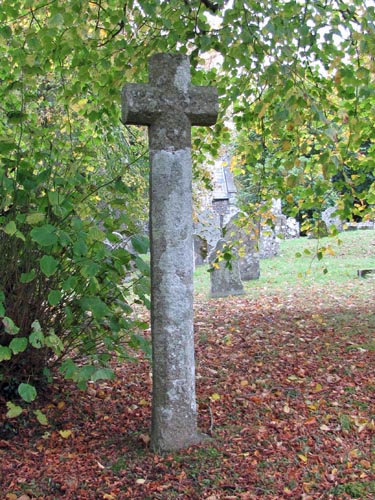 Location:
Next to a large tree on the grass and
to the right of the path, just inside the west gate of the churchyard. Location:
Next to a large tree on the grass and
to the right of the path, just inside the west gate of the churchyard.O/S Grid Ref: SX/58130/95087 Longitude/Latitude (Degrees+/-): -4.01190/50.73801 Map location: Click here to view map. Purpose: Churchyard Cross Size: 6 feet 8 inches (2.03 metres) tall. 1 foot 7 inches (0.48 metres) across the arms. The shaft is 8 inches (0.20 metres) wide and 7˝ inches (0.19 metres) deep. Information: This tall, octagonal cross shows an obvious join in the shaft, 20 inches (0.51 metres) down from the top of the cross. Harry Starkey recorded that the shaft was found nearby being used as a gatepost. It was rescued in 1928 and set up in its current position for protection. It was at this time a new head and arms were made to complete the cross. Although the new head and arms are a good match for the shaft, the difference in the ageing process of each stone is obvious for all to see. The shaft is octagonal in section and is splayed out at the base, which suggests that it never had a socket stone. Certainly the shaft is currently set directly into the ground. The join with the head and arms has been cemented to provide additional strength. It can also be seen that a hole in the eastern face of the shaft, which would once have held a gate-hanger, has been infilled with cement. An Ordnance Survey benchmark has been incised on the western face of the shaft, 5 feet 6˝ inches (1.69 metres) down from the top of the cross. It has been suggested that the original site for this cross was at the junction of the Hatherleigh road with the lane leading to the church. Leaning up against the roadside wall near the cross are a number of 18th century headstones, which make interesting reading. There is one with the skull and crossbones incised at the top, for Francis Richards who was the town tanner and who died in 1711. Of the others, one has an Egyptian style face together with a star at the top and another with a face set within a pair of wings. This latter headstone relates to ‘John Lane, of this town and corporation’, who died in 1793. The entrance door on the west end of the church shows the date of 1844 in large black numbers. The church, which is in a pleasant rural setting a little way from the town centre, is dedicated to All Saints. In the corner of the porch, at the entrance to the south door, is an ancient coffin lid cemented in an upright position. There is a framed noticed above the stone which tells its history, as follows: A RELIC FROM THE NORMAN
CHURCH
The stone has an elongated incised cross running down its length. The lower end is splayed into four feet and the head and arms widen out at the ends. The inscription, as set out above, can be seen running down one side of the cross and up the other. To the left of the cross, above the arm is engraved "HIC" and continuing below the arm is "JACET ROBER". Coming up the right hand side, below the arm is "TUS DE MO", with the "LIS" finishing off above the arm The stone measures 4 feet 8 inches (1.42 metres) tall, by 17 inches (0.43 metres) wide at the top and tapers down to 11˝ inches (0.29 metres) wide at the bottom. It is 7 inches (0.18 metres) in depth. The incised cross is 4 feet (1.22 metres) tall and 10 inches (0.25 metres) across the arms. |